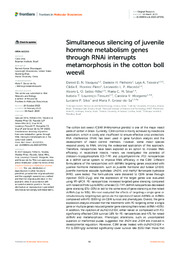Simultaneous silencing of juvenile hormone metabolism genes through RNAi interrupts metamorphosis in the cotton boll weevil.
Simultaneous silencing of juvenile hormone metabolism genes through RNAi interrupts metamorphosis in the cotton boll weevil.
Autoria: VASQUEZ, D. D. N.; PINHEIRO, D. H.; TEIXEIRA, L. A.; MOREIRA-PINTO, C. E.; MACEDO, L. L. P. de; SALLES-FILHO, A. L. O.; SILVA, M. C. M. da; LOURENCO, I. T.; MORGANTE, C. V.; SILVA, L. P. da; SA, M. F. G. de
Resumo: The cotton boll weevil (CBW) (Anthonomus grandis) is one of the major insect pests of cotton in Brazil. Currently, CBW control is mainly achieved by insecticide application, which is costly and insufficient to ensure effective crop protection. RNA interference (RNAi) has been used in gene function analysis and the development of insect control methods. However, some insect species respond poorly to RNAi, limiting the widespread application of this approach. Therefore, nanoparticles have been explored as an option to increase RNAi efficiency in recalcitrant insects. Herein, we investigated the potential of chitosan?tripolyphosphate (CS-TPP) and polyethylenimine (PEI) nanoparticles as a dsRNA carrier system to improve RNAi efficiency in the CBW. Different formulations of the nanoparticles with dsRNAs targeting genes associated with juvenile hormone metabolism, such as juvenile hormone diol kinase (JHDK), juvenile hormone epoxide hydrolase (JHEH), and methyl farnesoate hydrolase (MFE), were tested. The formulations were delivered to CBW larvae through injection (0.05?2 ?g), and the expression of the target genes was evaluated using RT-qPCR. PEI nanoparticles increased targeted gene silencing compared with naked dsRNAs (up to 80%), whereas CS-TPP-dsRNA nanoparticles decreased gene silencing (0%?20%) or led to the same level of gene silencing as the naked dsRNAs (up to 50%). We next evaluated the effects of targeting a single gene orsimultaneously targeting two genes via the injection of naked dsRNAs or dsRNAs complexed with PEI (500 ng) on CBW survival and phenotypes. Overall, the gene expression analysis showed that the treatments with PEI targeting either a single gene or multiple genes induced greater gene silencing than naked dsRNA (~60%). In addition, the injection of dsJHEH/JHDK, either naked or complexed with PEI, significantly affected CBW survival (18% for PEI nanoparticles and 47% for naked dsRNA) and metamorphosis. Phenotypic alterations, such as uncompleted pupation or malformed pupae, suggested that JHEH and JHDK are involved in developmental regulation. Moreover, CBW larvae treated with dsJHEH/JHDK + PEI (1,000 ng/g) exhibited significantly lower survival rate (55%) than those that
Ano de publicação: 2023
Tipo de publicação: Artigo de periódico
Unidade: Embrapa Semiárido
Observações
1 - Por padrão são exibidas publicações dos últimos 20 anos. Para encontrar publicações mais antigas, configure o filtro ano de publicação, colocando o ano a partir do qual você deseja encontrar publicações. O filtro está na coluna da esquerda na busca acima.
2 - Para ler algumas publicações da Embrapa (apenas as que estão em formato ePub), é necessário ter, no celular ou computador, um desses softwares gratuitos. Sistemas Android: Google Play Livros; IOS: iBooks; Windows e Linux: software Calibre.
Acesse outras publicações
Acesse a Base de Dados da Pesquisa Agropecuária (BDPA) para consultar o acervo completo das bibliotecas da Embrapa.

